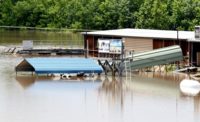Ominous Reports: The 1927 Mississippi Flood
 |
| Southerners stranded by the high waters. (Photo by American Environmental Photographs Collection) |
“As this is written, most ominous reports come from the Mississippi Valley.”—April 21, 1927
Those are the first words of significance that appeared in Engineering News-Record as one of the great disasters of U.S. history unfolded. Before it was over, broad swathes of the Mississippi River valley, including millions of acres of farmland and two parishes of New Orleans, were devastated. Hunger and sickness were widespread. Eventually, resentment surrounding the catastrophe would help propel Herbert Hoover into the White House.
As the drama of the 1927 disaster became clearer, and a near-obsessive interest in it gripped American newspapers and their readers, Engineering News-Record, in the editorial commentary that follows, provided a cool and sometimes eloquent discussion of the failures and the grave issues involved. Separate lengthy reports on the details of the flooding also were published.
While Hurricane Katrina is not directly comparable to the 1927 disaster, some of the issues, such as the question of whether levees alone are enough to cope with the Mississippi’s periodic inundations, have echoes in today’s post-Katrina investigations. Parallels are also apparent in the issue of deforestation and flood control and today’s worries over wetland destruction. Finally, then as today, Congress and the president are prominent players in all the questions regarding flood control, funding of the infrastructure and the apportioning of blame by an outraged public that feels it has been ill-served.
|
Hope and fear over levees
A typhoid epidemic had broken out in Montreal, and President Coolidge had asked the Secretary of War to investigate the feasibility of a ship canal through the Nicaraguan isthmus. But the biggest news that week was the swollen Mississippi.
The rains and melting snows of the entire Mississippi Valley, a third of the area of the continental United States, contribute to make the Mississippi River. When rainfalls so occur as to concentrate at the tributary mouths with melting snows from the north and the waters from the other swollen tributaries, we have floods. Expectation of record high water in the river has always been based on something short of the worst combination of these tributary floods, but today we have almost a record flow in the upper river meeting the lower river swollen by tremendous rainfall—and the combination will produce flood heights behond anything on record.
The country will await with hope, mixed with a large degree of fear, the behavior of the levees in this threatened district.
 |
| .A broken levee in 1927. (Photo courtesy of Department of Special Collections, University of Chicago Library.) |
April 28, 1927
The flood moves South
Just how great is the flow is not known at the present time, for the volume measurements have not been announced, but the gages near the flood’s crest are the highest on record. For some weeks the peril of the lower river will continue, since all the water that goes into the Mississippi must eventually go out its lower valley, no matter how many breaks in the levee system bypass the flow for a time. From Memphis south, then, the next few weeks will be a period of increased watching, of piling sand bags and driving timbers, of loading earth and guarding sandboils. And not until the crest has long passed to the gulf will the valley rest secure and begin again to bind up its wounds. Meanwhile, however, it is not necessary to fall a prey to hysteria. There have been floods before on the Mississippi, and their toll has been greater than this one so far has taken. The dangers so far have been the dangers of submergence, which are bad enough but which are not to be compared with the rush of waters from behind a broken dam. The towns and farms are not meeting a torrent, they are being subjected to a creeping flood that crawls up the sides of the buildings an inch or two, or at most, a foot an hour. Submergence is bad, the losses are great, but until a levee breaks in front of a city the worst horrors of a flood are not experienced. The significance of the present flood has so far lain in its extended area rather than it difference from the Mississippi floods of the past, and every one will do well to read the accounts of its progress with that thought in mind.
May 5, 1927
The problem of the Mississippi
In the intervals between Mississippi floods only those charged with responsibility for the river think very much about it. As soon as the water overflows the land once more the century old problem takes on new life and every one, amateur and expert alike, rushes into the argumentative fray. The methods used on the Mississippi have not been completely successful, else there would be no inundation. But the river is in flood, high water marks are being exceeded and large areas are being submerged down the whole valley. The average citizen—long trained to expect the impossible from the engineer—wonders why this thing is allowed to go on and passes by easy stages to acceptance of all or most of the advertised solutions which are offered.
Congressmen wire the President that the flood “is a part of the tragic price we will all pay for our folly of forest devastation” and the Secretary of the Treasury and Senator Curtis, according to press reports, agree that “the best approach would be by construction of storage reservoirs on the headwaters of the Mississippi to impound surplus waters during flood periods and distribute it for power production or irrigation.” Contour plowing, outlets, spillways, parallel channels—all the old familiar alternatives and correctives to the levee system—are brought forth just as they have been again and again for the last fifty years.
Later on, the editorial continues:
There is, for instance, no proof that deforestation has increased floods, and even if there were such proof, nothing can be done about it so far as the Mississippi is concerned. Certainly, no restoration of forests can effectively be made in this great valley with all of the appendages of modern civilization that have grown up there. Similarly, there are basic fallacies in the conception of headwater pools to catch the rain as it falls and to hold it to be led down to the main river if and as desired, meanwhile gaining power thereby from the effective head through the generation of electric energy. You cannot hold water and use it too, nor can there be found space in the head valleys of the tributaries where adequate reservoirs can be built for any sum within reason. And if such money could be provided, man has not sufficient prescience always to dispatch the waters from this multitude of reservoirs, from the Rockies to the Appalachians, from Santa Fe to Pittsburgh, so that they will reach the Mississippi at intervals that will not conflict to cause flood.
The ultimate levee program for the control of the floods of the Mississippi contemplates parallel levees extending from above the Ohio to the delta and up the tributary streams, all at an elevation sufficient to retain the river at any flood that comes. Money has not been made available, however, either by local communities, state or federal government, and the levees still fall far short in extent of those necessary to a complete scheme and only for a part of their extent do they reach the present designed final height. The time when such a system would be completed is far off. Every new levee that is built, every foot that is put on top of an old levee, makes necessary higher and stronger levees below. The question inevitably arises: “How far can we continue the process?”
Would it be better to conceive of these basins (that comprise the Mississippi River) as temporary lands, merely retrieved for a time from the waters, and to be used always with the possibility of enforced flooding in view?
In the week that followed, as the crest of the Mississippi flood passed Natchez, the threat of crevasses in levees protecting the lower river and Southern Louisiana became clearer.
 Related Links:
Related Links: 




